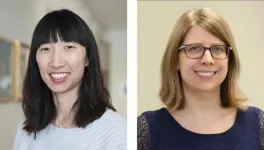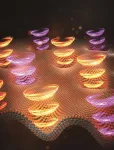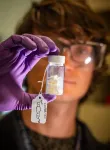(Press-News.org) A stem cell patch developed by USC researchers for patients with macular degeneration will soon be tested in a phase 2b clinical trial.
This latest milestone in the patch’s development was made possible by a combined $21 million in support from a state organization, a nonprofit foundation and the university. Last month, the California Institute for Regenerative Medicine (CIRM) awarded an estimated $12.4 million to the USC-supported startup Regenerative Patch Technologies (RPT) to test the safety and efficacy of the patch for treating advanced dry age-related macular degeneration, also known as “geographic atrophy.”
The award from CIRM, a state institute that supports research to address unmet medical needs, is the latest round of funding for the startup. USC and The Marcus Foundation were also influential in the award.
Key supporters
To qualify for CIRM funds, applicants must have a substantial amount of co-funding. USC Research and Innovation provided a $2 million promissory note to partially fulfill the co-funding requirement. The Marcus Foundation in Atlanta also played a critical role, providing USC researcher Mark Humayun and the university with more than $7 million in a peer-reviewed grant for this novel, transformational stem cell research program at USC that is aimed at curing blindness.
“I want to thank USC President Carol L. Folt for supporting this important research, as well as USC Research and Innovation for all the work they did to make this possible,” said Humayun, director of the USC Ginsburg Institute for Biomedical Therapeutics and co-director of the USC Gayle and Edward Roski Eye Institute. “I would also like to thank The Marcus Foundation for their generous support after a thorough review process.”
USC Research and Innovation’s award came from a first-of-its-kind, dedicated research program that supports USC faculty partnerships with small businesses to plan competitive funding applications.
“We are thrilled to support this critically important medical innovation by fostering the university’s ongoing technology transfer and commercialization efforts through faculty partnerships with small businesses,” said Ishwar K. Puri, senior vice president for USC Research and Innovation.
A patch with promise
Geographic atrophy affects more than 1 million Americans ages 40 and older, according to data from the Centers for Disease Control and Prevention. Currently, there is no therapy to improve vision in patients who have the condition.
Research on the patch so far has indicated positive results. It appears to restore the structure and function of the retina to improve vision. The phase 2b clinical trial will involve evaluating the efficacy of the implant in 24 patients who have suffered vision loss from geographic atrophy.
The disease affects a vital group of cells: retinal pigment epithelium (RPE) cells. When healthy, these cells enable photoreceptor cells of the retina to detect light. With geographic atrophy, RPE cells degenerate over time. This can lead to photoreceptor loss, impaired vision and, for many, blindness, forcing some patients to lose their independence.
“CIRM is proud to continue to fund this groundbreaking stem cell therapy that has the potential to improve outcomes for the millions of people suffering from geographic atrophy,” Maria T. Millan, president and chief executive officer of CIRM, said in an announcement of the award. “This investment is follow-on funding to CIRM’s previous support to develop this therapy. It reflects our commitment to advancing cutting-edge science and underscores our dedication to addressing the unmet medical needs of those affected by degenerative diseases.”
The researchers realizing the vision
Humayun and his fellow co-founders of Regenerative Patch Technologies — Dennis Clegg, professor in the department of molecular, cellular and developmental biology at the University of California, Santa Barbara; and the late David Hinton, professor of ophthalmology and pathology at USC — had developed the core technology for the stem cell-based subretinal implant.
The implant, named the “California Project to Cure Blindness-Retinal Pigment Epithelium 1” or CPCB-RPE1, is licensed by the USC Stevens Center for Innovation exclusively to Regenerative Patch Technologies.
The phase 2b clinical trial at USC will be led by Sun Young Lee and Rodrigo Antonio Brant Fernandes, both MDs and faculty members at the USC Roski Eye Institute.
Previously, the Alfred E. Mann Institute at USC had provided support for the initial development of the implantable patch as an incubator for new USC-related companies.
About the California Institute for Regenerative Medicine (CIRM
CIRM, was created by the people of California to accelerate stem cell treatments to patients with unmet medical needs, and act with a sense of urgency to succeed in that mission.
To meet this challenge, CIRM’s team of highly trained and experienced professionals actively partners with both academia and industry in a hands-on, entrepreneurial environment to fast-track the development of today’s most promising stem cell technologies.
END
USC-supported startup receives major grant for clinical trial of a promising eye treatment
$12.4 million from the California Institute for Regenerative Medicine is the latest round of support for USC researcher Mark Humayun and a milestone in the development of a stem cell patch to treat advanced dry age-related macular degeneration.
2023-08-24
ELSE PRESS RELEASES FROM THIS DATE:
New detector paves the way to large-scale optical neural networks
2023-08-24
For the first time, researchers have used a surface normal nonlinear photodetector (SNPD) to improve the speed and energy efficiency of a diffractive optical neural network (ONN). The new device lays the groundwork for large-scale ONNs, which can perform high-speed processing at the speed of light in an extremely energy efficient manner.
Farshid Ashtiani from Nokia Bell Labs will present this research at Frontiers in Optics + Laser Science (FiO LS), which will be held 9 – 12 October 2023 at the Greater Tacoma Convention ...
The right combo: Getting the most health benefits from fruit smoothies
2023-08-24
Smoothies can be a tasty and convenient way to get the important fruits and vegetables you need for a healthy diet. But is a banana and blueberry smoothie the best combo? Researchers at the University of California, Davis, suggest that blending certain ingredients in smoothies can influence whether your body is getting a nutritional boost.
The study, published today in the Royal Society of Chemistry’s journal Food and Function, used smoothies to test how various levels of polyphenol oxidase, an enzyme in many fruits and vegetables, affects the levels of flavanols in food to be absorbed by the body. Flavanols ...
$12 million grant funds foundational research on early liver transplantation
2023-08-24
Alcohol-associated liver disease accounts for 50% of liver-related deaths, and its rates are rising worldwide. But one of the best treatment options, early liver transplantation (ELT)—transplants done with no mandatory period of abstinence from alcohol—is also one of the most controversial, partly because of concerns that patients will relapse to alcohol after transplantation.
Part of the problem is that livers for transplants are in short supply, and researchers lack data to determine who will benefit most from ELT. Studies show that decisions about who gets a transplant can, at times, be influenced by bias or unsystematic. ...
Study shows technology boosts public health programs
2023-08-24
An examination of the SCALE-UP Counts program was recently published in the journal Pediatrics. This analysis, led by Yelena Wu, PhD, investigator at Huntsman Cancer Institute and associate professor in the department of dermatology at the University of Utah (the U), and David Wetter, PhD, MS, investigator at Huntsman Cancer Institute and professor in the department of population health sciences at the U, received support from RADx-Underserved Populations (RADx-UP) and funding from the National Institute of Health (NIH).
The SCALE-UP Counts program was designed to promote COVID-19 testing through collaboration ...
A global observatory to monitor Earth's biodiversity
2023-08-24
At a time of nature crisis driven by unparalleled rates of biodiversity loss, a new interconnected system to monitor biodiversity around the world is urgently needed to direct and focus conservation action.
"The lethal combination of habitat loss, the exploitation of natural populations, pollution, and climate change is causing species extinction rates not seen since the last mass extinction 65 million years ago," said Prof. Andrew Gonzalez, Liber Ero Chair in Conservation Biology at McGill University, and co-Chair of GEO BON. "We lack the means to monitor these impacts ...
High drug price associated with decreased treatment retention for patients with chronic liver disease
2023-08-24
MINNEAPOLIS/ST. PAUL (08/24/2023) — Researchers from the University of Minnesota Medical School and College of Pharmacy have found that high costs for hepatic encephalopathy treatment in patients with end-stage liver disease were associated with decreased treatment retention for patients. The study results were recently published in Hepatology Communications.
Hepatic encephalopathy is the loss of brain function that occurs in people with severe liver disease. The condition is associated with high morbidity and mortality. ...
Optimizing tobacco cessation treatment with lung cancer screening
2023-08-24
MINNEAPOLIS/ST. PAUL (08/24/2023) —Lung cancer is the deadliest cancer in the United States, and 80% of lung cancer deaths are linked to one risk factor: smoking. While lung cancer screenings are a critical part of prevention and treatment for the disease and 15 million Americans qualify for yearly screenings, over half those eligible for screenings are still actively smoking. Without standard smoking cessation measures in place, the benefits of the screenings have not been fully realized.
New ...
New quantum device generates single photons and encodes information
2023-08-24
A new approach to quantum light emitters generates a stream of circularly polarized single photons, or particles of light, that may be useful for a range of quantum information and communication applications. A Los Alamos National Laboratory team stacked two different, atomically thin materials to realize this chiral quantum light source.
“Our research shows that it is possible for a monolayer semiconductor to emit circularly polarized light without the help of an external magnetic field,” ...
Making materials more durable through science
2023-08-24
ALBUQUERQUE, N.M. — A team at Sandia National Laboratories developed a molecule that helps change the way some materials react to temperature fluctuations, which makes them more durable. It’s an application that could be used in everything from plastic phone cases to missiles.
Polymers, which include various forms of plastics, are made up of many smaller molecules, bonded together. This bond makes them especially strong and an ideal product to be used to protect delicate components in a wide variety of items. But with time, use and exposure to different environments, all materials begin to deteriorate.
Hot ...
New framework for oceanographic research provides potential for broader access to deep sea scientific exploration
2023-08-24
Woods Hole, Mass. (August 23, 2023) -- Scientific exploration of the deep ocean has largely remained inaccessible to most people because of barriers to access due to infrastructure, training, and physical ability requirements for at-sea oceanographic research.
Now, a new and innovative framework for oceanographic research provides a way for shore-based scientists, citizen scientists, and the general public to seamlessly observe and control robotic sampling processes.
The Shared Autonomy for Remote Collaboration (SHARC) framework “enables remote participants to conduct shipboard operations and control ...
LAST 30 PRESS RELEASES:
The Lancet: COVID-19 vaccine hesitancy decreased over time, though mistrust persists among certain groups, study of over 1 million people in England suggests
Psychosis patients ‘living in metaphor’ -- new study radically shifts ideas about delusions
Clinical trial in Ethiopia targets the trachoma scourge
Open-sourcing the future of food
Changes in genetic structure of yeast lead to disease-causing genomic instabilities
UC San Diego Health Sciences Grant Writing Course helps launch successful research careers
Study: Many head and neck cancer trials end early. Why?
Tufts vice provost for research named Foreign Fellow of Indian National Science Academy
New model improves prediction of prostate cancer death risk
Two wrongs make a right: how two damaging variants can restore health
Overlooked decline in grazing livestock brings risks and opportunities
Using rare sugars to address alcoholism
Research alert: New vulnerability identified in aggressive breast cancer
Ruth Harris honored with SSA Distinguished Service Award
Treasure trove of data on aging publicly accessible
Trees4Adapt project to address risks from climate change and biodiversity loss through tree-based solutions
Nature Communications study from the Lundquist Institute identifies molecular mechanism underlying peripartum cardiomyopathy
Pennington Biomedical’s Dr. Gang Hu appointed to NIH Reproductive, Perinatal and Pediatric Health Review Group
World-first project shows great promise to treat low eye pressure
New technique puts rendered fabric in the best light
Brain cancer digital twin predicts treatment outcomes
Cat disease challenges what scientists thought about coronaviruses
Paulson Family Foundation makes an additional $19 million donation to Hebrew University to fund a new building for electrical engineering. Together with its previous gift brings the total donation to
Canada–Estonia partnership advances community-centered clean energy
Sandia’s economic impact sets record for 17th consecutive year
Researchers uncover how tumors become resistant to promising p53-targeted therapy
Aligning games and sets in determining tennis matches
UOC research team develops method to evaluate apps for treating depression
Extreme heat waves disrupt honey bee thermoregulation and threaten colony survival
New brain study explains how binge drinking contributes to long-lasting negative feelings
[Press-News.org] USC-supported startup receives major grant for clinical trial of a promising eye treatment$12.4 million from the California Institute for Regenerative Medicine is the latest round of support for USC researcher Mark Humayun and a milestone in the development of a stem cell patch to treat advanced dry age-related macular degeneration.




